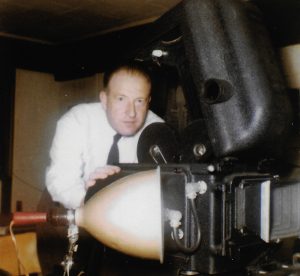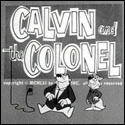
I became a big fan of Cambria Studios’ Clutch Cargo cartoon when I was a boy. The series, while a few years old, was broadcast via a local station in the mid-1960’s. As simple as it was, the cliff-hanger chapters of a story kept me on the edge of my seat.

Clark Haas Jr. 1937
Ritchard Brown started Cambria in 1956, and dabbled in live-action projects without success, until 1958, when he paired up with comic strip artist, Clark Haas, and inventor and cameraman, Edwin Gillette. Haas created Clutch Cargo and his pals Spinner and Paddlefoot. Gillette was the person, with special effects man Scotty Tomany, who put things into motion. Combining Gillette’s Syncro-Vox system of projecting human lips on static art, with an upright, moving ANIMAC, Tomany utilized small props set in motion, resulting in television’s “first moving comic strip.”
Margaret Kerry, who will be celebrating her 90th birthday on the 11th of next month, calls herself “the last remaining person who was there” when it all happened. Kerry, the wife of Cambria founder Ritchard Brown, did some office work and the voices of Spinner, Paddlefoot and many others. Her memories of working beside Brown, Haas, Gillette, voice artists Richard Cotting and Hal Smith, as well as others, remain vivid. Her recollections provide the last window into the series.

Hal Smith, Margaret Kerry, Richard Cotting recording
Kerry spoke to me about how much disinformation about the series has surfaced on the internet and elsewhere. According to her, Emil Sitka, who did voice work for Cambria, was never in a Clutch recording session. Sitka came after the series was completed. Clark Haas was not a founder of Cambria Studios, as stated earlier, he joined on two years after. Kerry said Clark and Ritchard did enter into an agreement, or a “partnership,” then. Hass didn’t come up with series character Swampy, that was Hal Smith’s doing. And the first station to broadcast Clutch Cargo was KULR-TV, channel 9, in Kalispell, Montana, on March 9th, 1959.
What Kerry didn’t know was that Clutch was only on KULR for two months before the station went off the air and out of business.

One amusing backstory is about the bonds put up by Ritchard Brown’s Uncle Mark, as collateral to borrow against, to establish Cambria Studio. Clutch historians are familiar with “Uncle Mark,” but perhaps not how he made his money. Mark Pierce was the owner of Pierce Brothers Mortuaries. So, essentially, the entity that made its business in death gave Clutch life.
Cambria began as a family business. Mark’s cousin, who managed the mortuary and Cambria’s financial side, was the treasurer of George Bagnall and Associates, Inc., who became the distributor of the Clutch Cargo series.
52 adventures were produced, each containing five chapters. In one adventure, Kerry had the flu, so they worked her hoarse voice it into the script by giving Spinner a cold. She conveyed that she, Hal Smith, Richard Cotting, Edwin Gillette, and sound engineer Clarence Thompson shared a lot of laughs in the studio, recording dialogue captured on film.
Sometimes it had to do with the absurdity of the scripts, sometime awkward scenarios. One in particular, she recalled, had to do with a character she voiced named Agent X.
“Agent X is standing there, jet black hair, sinister Russian accent, looking very much like a spy,” she said. “And Clutch is standing in front of her, looking right at her, wondering who the spy might be? He just didn’t get it.”
 An eruption of laugher sometimes occurred when a line came out of nowhere. Something not in the script, like in “The Desert Queen” episode.
An eruption of laugher sometimes occurred when a line came out of nowhere. Something not in the script, like in “The Desert Queen” episode.
“Hal Smith had this line that we couldn’t get past, and we had to jump to something else,” she said. “My line was, ‘Gee, how are we going to get out of this, Clutch?,’ to which Cotting responded, ‘Did you ever see a camel ladder, Spinner?’ The camel would turn into a ladder, and they could climb up the ladder. The line came out of nowhere, and sure enough, they left it in.”
Out of all of the fan mail the show received, one letter, in particular, still stands out in Margaret Kerry’s mind.
“It was from an Idaho university professor who had questions from his class on animation and writing for animation,” She said. “They wanted to know how the writers of Clutch Cargo work psychologically to get these very deep and interesting stories. I’m not joking.”
Ritchard Brown, who received the letter, burst into laughter and responded.
“He wrote a letter back and answered, ‘We drink a lot of coffee and pray,’” Kerry recalled. “I mean, look at those stories. They’re psychologically deep?”
NOTE: The new Cartoon Research mini-book is on sale NOW! – Jerry Beck











































I added the book to the Wikipedia entry. Bravo for casting light on out of the way corners of animation history.
Thanks, Dana for adding the book to Wikipedia. Margaret Kerry was gracious and was an enormous asset, and Jim Engle provided help with graphics and offered great support!
Many many years ago, I read an article in a magazine that my local public library had (it was some sort of theatre magazine) that discussed the Synchro-Vox process and “Clutch Cargo.” I was impressed by a photo in the article that showed someone’s head literally strapped into a device so they wouldn’t move while their lips were being filmed. The “live lips” imagery always seemed mildly creepy to me.
Part of the “creepy” appearance was due to the fact that the jaws and cheeks do not move with the mouths. And the superimposition of the live action lips are soft, in contrast the the sharp lines of the cartoon drawings. This gives the mouths a “ghostly” impression.
Count me in the ‘creeped out’ camp. Those cartoons were unwatchable to me as a kid. Space Angel was the only other cartoon I know of that used the process. Same creepy effect.
That’s because both series were done by Cambria.
Am I the only person on the internet who doesn’t find the live-action lips creepy?
Love that behind the scenes shot of the voice actors at a recording session. Thanks for posting it. 🙂
I would rather have an overview of the studio and analysis of all their product, not just a focus on this one series. Pass.
It’s $8.95. Don’t cut off your nose to spite your face, and don’t hold your breath on the full studio book.
I knew Emil Sitka was involved in The New Three Stooges for Cambria, but did not know he was involved with any other Cambria productions.
There was a third show, “Captain Fantom”, involving the crew of a submarine. It was a half-hour show divided into three titled episodes, so it could run as a serial as well.
Was there a point when TV animation studios shifted primarily to half-hour shows as opposed to shorts and serials to drop into hosted kiddie shows? You’d still have shows divided into three segments, but each would have a simple title card instead of its own title sequence.
I remember visiting Cambria Studios when Cluck Cargo was still in production. I remember Dick Brown giving me a tour of the equipment, including the circular rotating cylinder that served as a continuous sky pan.
Clutch Cargo lives on the Classic Toons channel on Pluto TV, at least as of this writing. I don’t get creeped out at all by the moving lips, but then I always loved those real cows, horses and other animals in those 1930’s shorts that had superimposed moving lips, usually singing something, I think.
i recently watched some of the episodes and noticed a resemblance to Race Bannon from Jonny Quest .
On my Roku I click on the old cartoons apps. I enjoyed watching Clutch Cargo,Casper the Friendly Ghost, many others… Favorites had long been forgotten, primitive absolutely, the lips, body movements. I’m still on the edge of my seat wondering if Clutch and friends will survive this episode; I love the Warner Bros cartoons… and Disney’s cartoons, but money talks, Theme parks, DVDs, apparel, these toons will be available for generations, but because of the OLD CLASSIC, BABY BOOMER CARTOONS app hopefully they won’t be forgotten!
Why wasn’t it renewed for another season?